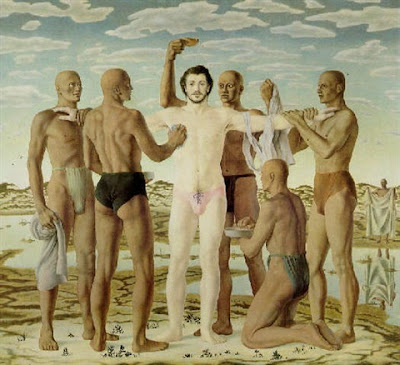The Vital Gay Universe: 7 (of 7)
The final sequence of SSfaSP is "A Lover’s Recourse". Technically, this includes 49 ghazals. Each ghazal is made from 7 shers (couplets), includes a radif (mono-rhyme at the end of each couplet), and concludes with a maqta (poetic signature or tag). (The form, as used by Jee Leong Koh, does not include a set metre and a set rhyme that runs through all the odd-numbered lines). This variation on the ghazal is effective, allowing both openness and closure, a sense of variation and linkage. The sequence itself alludes to Roland Barthes’ A Lover’s Discourse (1978). This text was defined by its author as a “running here and there”, an apt description for the work is deliberately without style, is not allowed to unify into a portrait of Barthes or to become a love story. In choosing Barthes as a point of departure, and it is a point of departure, not agreement, the ghazals further Jee leong Koh’s interest in portraiture. The change of “Discourse” to “Recourse” intimates a different intent: the ghazals are a “turning towards”, giving support to a life. To echo Barthes, “So it is a lover who speaks and who says”…and that voice, in the seventh sequences, is that of a lover of poetry and men. “Bull Eclogues” offers no sense of transcendence. Religious hypocrisy is a lie to be condemned. In “A Lover’s Recourse”, which is intimate (rather than confessional), there is a real sense of substance and personal transubstantiation. A reader experiences a mind in search of itself amidst the minutiae of existence. There is a Hermetic maxim, with biblical basis, that the most insignificant stone rejected could be the one of greatest value. That sense runs through “A Lover’s Recourse”, as images are returned to within a ghazal and themes are returned to within the long poem. This is a poem outside Eliot’s Christian universe, beyond Evangelicanism; a poem which doesn’t speak to hermetical angels, but is Hermetic in its awareness that everything matters— not least of all being gay. The great strength of this sequence is that it is moral without moralizing— that is best left to a Christianity that has strayed from ethics and self-awareness.
Choose perfection of the life or of the work,
cries the large angel with a soft voice like a pigeon.
The final sequence of SSfaSP is a whole, but is marked into sevenths—river, stone, bed, pigeons, wound, fountain. This sher from the beginning of the third seventh (ghazal 22) takes its opening from W.B.Yeats’ “The Choice” (The Winding Stair, 1933). In that poem, Yeats recognises that an intellect which chooses Art hasn’t the time for Religion and in doing so must “refuse” Heaven. That is one significant theme in these ghazals: the devotion to poetry is a grand refutation. Another two significant themes occur in “Wound” and “Fountain”.
When I think I can live without being queer all my life,
a morning happens, and the scar unlocks the wound.
Increscunt animi, virescit volnere vitus, Jee.
Spirits increase and vigour grows, through a wound.Out of Nietzsche (via Gellius on Bibaculus), these shers acknowledge the Hermeticist’s sense of necessary wounding, a shamanic awareness that a wound opens up spiritual data.
And a core statement:
Jee, you may carry from the sun the finest stone.
A form, without love’s pressure does not make a fountain.
Rumi, Michelangelo, Duncan, all would pay tribute to that perception.
The poetry in “A Lover’s Recourse” shows “love’s pressure”, as the ghazals return to imagery of currents, flow, opening, containment, blocked entrance, penetration, holding to, routines, routes, and epiphany.
Nicholas Liu’s review of Seven Studies for a Self Portrait is a strong piece of reviewing. Its strength resides in the fact that it is strong enough to be argued with, so different to the thin poetry reviews which too often appear on the internet and in journals. He does Jee Leong Koh a great act of critical friendship by writing at length on the strengths and weaknesses, as he perceives them. I cannot test his claim that “A Lover’s Recourse” is the “most compelling long poem or poem sequence” in Singaporean literature. I would wish to claim equally, however, that the ghazals offer much enjoyment intellectually and emotionally and are a significant sequence in terms of other literatures, standing alongside Andrew Waterman’s Out for the Elements and D’Aguiar’s Elegies.
SSfaSP is a compelling sketch of how vital a gay identity can be.




Comments